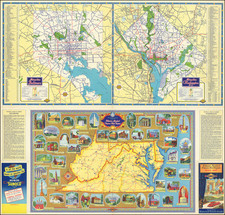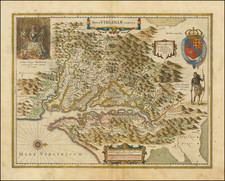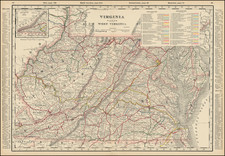The Mapping of the Secession of West Virginia. With Provenance to One of the Great Post-War Statesmen.
The remarkable thematic map of slavery in Virginia, compiled from recent census data and disseminated to help the Abolitionist and Union causes in the early days of the Civil War. The map shows the inherent divide between Virginia and what would become West Virginia more clearly than any other map produced up to that point. With proceeds from the sale of the map going to the benefit of the sick and wounded of the Union Army, this second edition is the first to introduce the idea of the State of Kanawha, or what would shortly become known as West Virginia. This example of the map is inscribed to Hamilton Fish, the legendary Secretary of State to Ulysses S. Grant, from William R. Palmer, who is now believed to be the author of the map.
First published less than one month after Virginia voted to secede from the Union on the 17th of April, 1861, this map sought to divide the richest of the Confederate states. By showing that the sociopolitical makeup was inherently different in the trans-Appalachian counties west of the Shenandoah Valley, this map argued that Virginians living in these areas would be fighting another class's war should they join the Confederacy. As such, secession from the rebellious state was the only answer.
This map was produced and updated contemporaneously with the progression of the Second Wheeling Convention, in which West Virginians delegates decided that their position as part of the Commonwealth of Virginia was untenable. The first edition, published on the 13th of June, shows no formal distinction between Kanawha and Virginia. By the time this second edition was published, sometime in the late summer, proposals for Kanawha had been made and were being pushed by the delegates. The third edition, published just seven days after the ratification of the secession of Kanawha on August 20th, 1861, formally recognizes this territory as a separate state.
Following the last edition of this map, Hergesheimer engraved a map showing the slave populations of all the Southern States in September of 1861. Inspired directly from the Virginia map, this map was so personally important to Lincoln that it is featured in the depiction of the reading of the Emancipation Proclamation held in the US Capitol.
This map was disseminated by and for the leading abolitionists and unionists of the day, as evidenced by the provenance, and its knock-on effects on the fragmentation of Virginia are momentous. The map can be classed in that highest realm of Americana, consisting of documents that not only chart the progression of events of national importance but that also influence the course of these events.
William R. Palmer and the Authorship of the Map
New research by Dr. Susan Schulten, a renowned cartographic expert on the history of the statistical mapping of the Americas, shows that this map was almost certainly produced by William Palmer, who dedicated this map to Mr. Hamilton Fish. A number of copies of this map that survive in institutional, federal, and military collections bear the inscription of Palmer's name or initials. Schulten identified a variety of these, and located one in which Palmer identified himself as "the Author."
Palmer certainly had the standing and the training to produce such a map. A major in the U. S. Topographical Engineers, he served throughout the war at the highest level for the Union. Some have also commented that this map has a demeanor akin to many of the Coast Survey maps - this is likely due to the involvement of Edwin Hergesheimer as lithographer, who was a German emigree also employed by the Coast Survey to produce some of their maps.
Hamilton Fish
This map is inscribed by Palmer to "Hoble Hamilton Fish by his friend." Fish was one of the great Republican politicians of New York, who served as Governor of New York and Senator from that state. During the Civil War, he was out of office but intimately involved in the war effort in a number of ways - he both dined regularly with Winfield Scott, was involved in the attempted resupply of Fort Sumter, and raised over $1,000,000 for New York State volunteers by 1862.
Following the War, he was nominated as Secretary of State under Ulysses S. Grant. He served in this position unwillingly, but is commonly considered to be one of the greatest people to have ever filled this role (with American Heritage even ranking him the third most capable Secretary of State). His negotiations abroad avoided war and allowed for the US to grow in its international prestige and power. Most notably, he managed to stay above the rampant corruption that plagued the Grant administration and proved a guiding light in that difficult period.
The State of Kanawha
Shown on the map is the State of Kanawha. As previously alluded to, this was the predecessor state to West Virginia, formed when counties favorable to the Union met to delegate during the Wheeling Convention. The first name proposed for the new state was Kanawha, after the Ohio River tributary and the Indian Tribe that originally inhabited the region. However, by December, the name for the state was changed to West Virginia as it was the name Kanawha was believed to be too confusing given the presence of Kanawha County, West Virginia's most populous.










![Carte Particuliere de Virginie, Maryland, Pennsilvanie, La Nouvelle Jarsey. Orient et Occidentale [Heighten in Gold!]](https://storage.googleapis.com/raremaps/img/small/61392mp2.jpg)
![[Amherst County Survey of 200 Acres Owned by Captain James Dillard dated 16, 1822]](https://storage.googleapis.com/raremaps/img/small/73745.jpg)


![(Powhatan Burial Practices) Regulorum Sepulcra XXII [Tombs of the Rulers]](https://storage.googleapis.com/raremaps/img/small/99647.jpg)